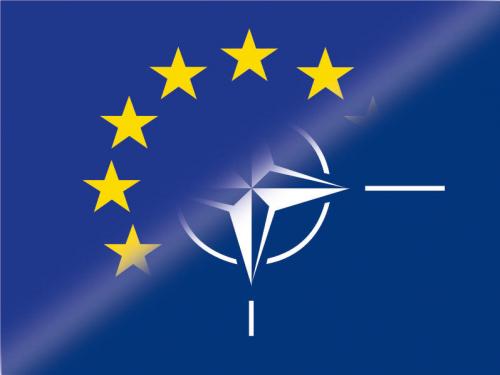
It would be a pity to let NATO fade away; because it will then have to be reinvented someday. And that will not be easy.
Today’s NATO is an increasingly dysfunctional organization, still searching for a new role two decades after the end of the Cold War. Left dangling in this state NATO will soon become irrelevant to the security needs of the Euro-Atlantic area. Worse, its internal tensions will continue to damage the already frayed transatlantic ties.
After speaking with forty military and government leaders, from the United States and Europe, I believe the answer to NATO’s woes is to bridge the alliance with the European Union’s Common Security and Defense Policy, or CSDP.
Cohesion used to be NATO’s hallmark, but there is little of it left. The Eastern and Central European members want NATO to act more aggressively against Russia, while the United States, Canada, and especially the the Western European members, with burgeoning trade relationships insist Russia is no longer a threat.
Incredibly, NATO aspires to become the hub for an anti-missile shield with Russia to protect people from Vladivostok to Vancouver, while it has a hard time finding a few hundred trainers for Afghanistan. And many of America’s largest NATO allies refuse to participate in the Afghan war handcuffed with national caveats that forbid them from fighting.
CSDP is the mechanism through which the EU deploys civilian and military missions to project its power and influence around the world. Still young—it was established in 1999—CSDP has already been used to deploy 27 missions from Africa to Asia.
If you are one of those who believe Europeans have been transformed into pacifists you have not heard about the EU’s eleven thousand troop mission to the land-locked African country of Chad (with 3,700 on the ground at one time, the rest in rotation). This mission was deployed under Irish and French command, to protect some 400,000 refugees in Darfur, Chad, and the Central African Republic. 27 European countries and Russia joined together under CSDP command to execute the operation.
Thousands of tons of military equipment, fuel and water had to first be shipped to Douala, Cameroon, on the East African coast, a two-week journey from Europe, and then transported another 1,700 km to Chad on rough roads. Military aircraft ferried special-forces troops to establish forward bases for an operation that ranged over 280,000 square km—more than half the size of France.
I asked General Pat Nash, the force commander, whether his troops were constrained with national caveats that prevent many European NATO members from participating fully in Afghanistan. His answer was an unequivocal, no. “The EU approved all the military rules of engagement I wanted in Chad,” Nash told me.
The EU force found itself militarily engaged in the first month of the deployment. The Europeans used helicopters to fight off the attacks. Over the 19 month campaign there were a number of fire-fights and EU casualties, including three deaths. The mission was successful and turned over command to the UN in March 2009. A far different outcome than appears likely for NATO in Afghanistan.
There are, I believe, three main reasons for the success of CSDP missions: Because the EU is a governmental entity it is able to use civilian, police, legal, and military components to tailor missions that are better geared to winning hearts and minds than NATO which is strictly a military organization; EU missions also overcome the objections some countries have to American led NATO forces on their territory. For instance, in the 2008 Georgia-Russia conflict, the EU arranged a ceasefire and deployed a CSDP mission to monitor it. Russia would never have accepted an American peace mission and would certainly not have permitted NATO monitors; Finally, CSDP is European owned and operated. It is Europeans making decisions in Europe’s national interests.
My discussions convinced me that with CSDP, the EU is capable of handling future conflicts in its backyard, such as another Bosnia or Kosovo. But as CSDP grows it will need a more robust integrated military planning and command infrastructure, instead of the ad-hoc commands it is now forced to set up for each mission.
NATO on the other hand has an outstanding and proven military command structure that it has perfected over its 60 year life time, it is just that the alliance does not have a mission left anymore.
For all these reasons, I believe it is time for the United States and the European Union to determine how to bridge NATO and CSDP. In the long term the Europeans will chart their own path in security and defense matters any way. A bridged military alliance will at least insure that the transatlantic allies remain connected for the times when Europe, America, and Canada wish to act together.
This change in the Euro-Atlantic security and crisis management structure can only be accomplished at the political level. A meeting between the U.S. Secretary of State and the EU’s High Representative for foreign and security policy might be a good way to jump-start the initiative.
Sarwar Kashmeri, the author of the forthcoming “NATO 2.0: Reboot or Delete,” is a senior fellow at the Atlantic Council’s International Security Program, and a fellow of the Foreign Policy Association.
Image: nato-EU_0.jpg
